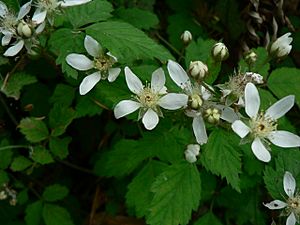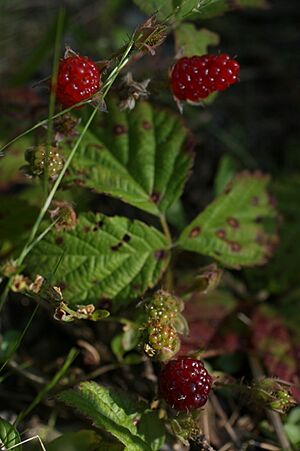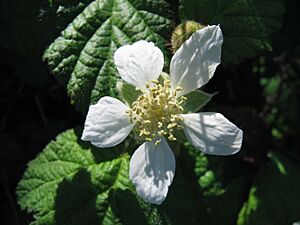California blackberry facts for kids
Quick facts for kids California blackberry |
|
|---|---|
 |
|
| Scientific classification | |
| Kingdom: | |
| (unranked): | |
| (unranked): | |
| (unranked): | |
| Order: | |
| Family: | |
| Genus: | |
| Subgenus: |
Rubus
|
| Species: |
R. ursinus
|
| Binomial name | |
| Rubus ursinus Cham. & Schldl. 1827 not Torr. & Gray 1840 nor (Weeber ex Sudre & Sabr.) Podp. & Domin 1928
|
|
| Synonyms | |
Rubus ursinus is a type of blackberry or dewberry plant found in North America. It has many common names, like California blackberry, Pacific blackberry, and trailing blackberry. The name Rubus comes from a word meaning "bramble," and ursinus means "bear." This is because bears love to eat its berries!
Contents
Where Does the California Blackberry Grow?
This plant grows naturally in western North America. You can find it in British Columbia (Canada), and in the U.S. states of California, Idaho, Montana, Oregon, and Washington. It also grows in the Baja California state in Mexico.
What Does the Trailing Blackberry Look Like?
Rubus ursinus is a wide, bushy plant or vine. It can grow from 2 to 5 feet (0.6 to 1.5 meters) tall and spread more than 6 feet (1.8 meters) wide. Its branches have small thorns. If a branch touches the soil, it can grow roots. This helps the plant spread and form large groups.
The leaves usually have three smaller leaflets, but sometimes they have five or just one. These leaves fall off in the autumn. This plant is special because it has separate male and female plants. This is not common for plants in the Rubus family. Like other Rubus plants, its stems (called canes) usually grow for one year. Then, in the second year, they produce flowers and fruit.
Flowers and Fruit
The flowers are white and have petals that are narrower than most other related plants. They also smell very nice! The fruits are sweet and have a strong smell. They can be dark purple, dark red, or black. Each fruit can be up to 0.8 inches (2 centimeters) long.
Different Types of Rubus ursinus
There are a few different types, or subspecies and varieties, of Rubus ursinus:
- Rubus ursinus subsp. macropetalus — found across its whole range.
- Rubus ursinus subsp. ursinus — found in California and Oregon.
- Rubus ursinus var. sirbenus — found only in California.
- Rubus ursinus var. ursinus — also found in California and Oregon.
How People and Animals Use This Plant
Many different animals love to eat the berries of Rubus ursinus. These include songbirds, deer, bears, and other small and large mammals. The plant is also very important for bees and bumble bees. They get pollen from its flowers and use parts of the plant to build their nests.
This blackberry is also a food source for the caterpillars of several butterflies. These include the western tiger swallowtail butterfly, the mourning cloak butterfly, the gray hairstreak butterfly, and the spring azure butterfly.
Traditional Uses by Native Americans
Native American groups, like the Kumeyaay, Maidu, Pomo, and Salish, used Rubus ursinus in many ways. They ate the berries fresh or dried them for later. They also used the plant as a traditional medicinal plant to help with illnesses. The Concow tribe, a part of the Maidu people, calls this plant wân-kö-mil′-ē in their language.
Growing Rubus ursinus in Gardens
People also grow Rubus ursinus for its tasty fruit and because it looks nice in gardens. It's often planted in home gardens, native plant gardens, and wildlife gardens. You can train it to grow along fences or on special frames called trellises. Once the plant is grown, it can help keep soil from washing away along creek banks and in bioswales (special ditches that help clean water).
For the plant to grow large fruits, it needs a steady amount of water. But once it's established, it can handle some dry periods. The smallest fully grown berries, about 1 centimeter (0.4 inches) big, are often considered the best. People sometimes call these "little wild blackberries."
Special Types of Berries
Rubus ursinus is a parent plant for some very famous berries:
- A special type of Rubus ursinus called 'Aughinbaugh' blackberry was used to create the loganberry.
- Rubus ursinus is also a grandparent plant for the boysenberry and the marionberry (also known as 'Marion' blackberry).
There's a type called 'Wild Treasure' that has the same great taste and size as wild berries. But it doesn't have thorns, and its berries can be picked by machines. This type was created in 2010. It's a mix between a Rubus ursinus plant and another thornless type called 'Waldo'.
Images for kids
See also
 In Spanish: Rubus ursinus para niños
In Spanish: Rubus ursinus para niños




